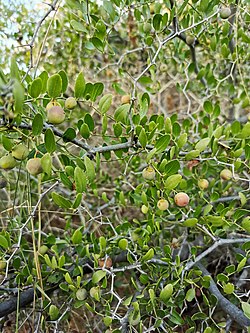Ziziphus lotus
| Ziziphus lotus | |
|---|---|

| |
| Scientific classification | |
| Kingdom: | Plantae |
| Clade: | Tracheophytes |
| Clade: | Angiosperms |
| Clade: | Eudicots |
| Clade: | Rosids |
| Order: | Rosales |
| Family: | Rhamnaceae |
| Genus: | Ziziphus |
| Species: | Z. lotus
|
| Binomial name | |
| Ziziphus lotus | |
| Synonyms[1] | |
| |
Ziziphus lotus is a small
Description
Ziziphus lotus can reach a height of 2–5 metres (6.6–16.4 ft), with shiny green leaves about 5 cm long. The edible fruit is a globose, dark yellow drupe of 1–1.5 cm diameter.[citation needed]
Cultural and religious references
Ziziphus lotus is often regarded as the lotus tree of Greek mythology.[2] It is thought to be referenced in the Odyssey, consumed by the Lotus-Eaters as a narcotic to induce peaceful apathy.[citation needed]
A sacred lotus tree planted near the temple of Vulcan in Rome was said to have been planted by Romulus, who is said to have been a contemporary of the composer[s] of the Odyssey (8th century BCE); it was still standing some 700 years later, in the time of Pliny the Elder.[3]
In Arabic-speaking regions, Ziziphus lotus, and alternatively Ziziphus jujuba, are closely associated with the lote-trees (sidr) which are mentioned in the Quran,[4][5] while in Palestine, it is rather Ziziphus spina-christi that is called sidr.[6] Elsewhere in the Arab world, the European and Chinese jujubes are also associated with the lote-trees (sidr).[7][8]
The 19th century English explorer
See also
References
- ^ The Plant List: A Working List of All Plant Species, retrieved 30 January 2016
- ^ Herodotus, Histories, Book IV, 177.
- ^
 Smith, William, ed. (1870). "Vulcanus". Dictionary of Greek and Roman Biography and Mythology.
Smith, William, ed. (1870). "Vulcanus". Dictionary of Greek and Roman Biography and Mythology.
- ^ Abdullah, Yusuf Ali (1946) The Holy Qur-an. Text, Translation and Commentary, Qatar National Printing Press.p.1139,n.3814
- ^ Stephen Lambden. "The Sidrah (Lote-Tree) and the Sidrat al-Muntaha (Lote-Tree of the Extremity): Some Apects of their Islamic and Bābī-Bahā'ī Intepretations [sic]". Retrieved 9 July 2019.
This is apparently the wild jujube or zizyphus spina-christi (Christ's thorn), a tall, stout, tropical tree (see image above) with dense prickly branches which produces a sweet reddish fruit similar to that of the jujube (the `unnāb = zizyphus vulgaris / fruit)
- ^ Easton, M.G. (1893). Illustrated Bible Dictionary and Treasury of Biblical History, Biography, Geography, Doctrine, and Literature. London, Edinburgh and New York: T. Nelson and Sons. p. 688.
- ^ Abdullah, Yusuf Ali (1946) The Holy Qur-an. Text, Translation and Commentary, Qatar National Printing Press.p.1139,n.3814
- ^ Stephen Lambden. "The Sidrah (Lote-Tree) and the Sidrat al-Muntaha (Lote-Tree of the Extremity): Some Aspects of their Islamic and Bābī-Bahā'ī Intepretations [sic]". Retrieved 9 July 2019.
This is apparently the wild jujube or Zizyphus spina-christi (Christ's thorn), a tall, stout, tropical tree (see image above) with dense prickly branches which produces a sweet reddish fruit similar to that of the jujube (the `unnāb = Zizyphus vulgaris / fruit)
- ^ Burton, Sir Richard Francis (1855) A Personal Narrative of a Pilgrimage to Al-Madinah and Meccah p. 337
